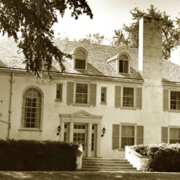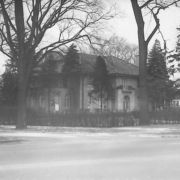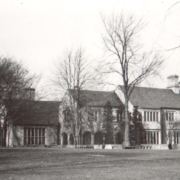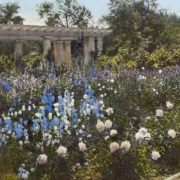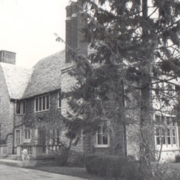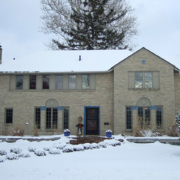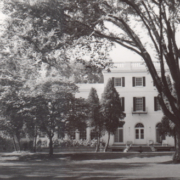Historical Architecture of Grosse Pointe – 16710 E. Jefferson – Part 1
Last week we explored the work of a lesser-known architect Hiram H. Hallett. His residential projects spanned a period of several decades and encompassed a broad spectrum of architectural styles. This week we are going to share the story of 16710 E Jefferson (now 8 Jefferson Court). Completed in 1897, the property is one of the older surviving homes in all the Grosse Pointe communities.
We first explored this home in 2020. However, we were recently contacted by Jeff Farkas, (who grew up in the house), and he asked if we could make a few updates to the post. Well, we did better than that, Jeff kindly sent us a detailed story. The following blog post is a recollection of Jeffs memories from his childhood and presents a fascinating history of the home. It was written by Jeff, edited by Katie Doelle, and is published with his permission.
This is Jeff’s story…
My father and mother, Don E. and Patricia B. Farkas, purchased and moved into 16710 Jefferson Ave. in the late summer of 1954. At that time, they had four sons, of whom I was the eldest. I lived in the house until 1967, when I married and moved to Ann Arbor. The last time I visited was in 1976.
The Early Years: property description
The house was purchased from Dorothy Shepherd. She told my father that the house had been used as a “rest home for seniors” (named the Lombardy Lodge Convalescent Home) during the 10 or so years prior to my parents’ purchase.
The original property lot was 60 feet wide [from the eastern edge of the house across to the western edge of the property driveway], and a gravel driveway entered the lot at Jefferson, on the western property line.
The original 995-foot strip ran down to the Lake. The prior owner partitioned this original strip into three separate lots. The first lot, which my father and mother purchased, ran from Jefferson nearly to the end of the gravel driveway, while the second lot [60’x 225’] and third [60’ x 260’, lakefront] were undeveloped. The driveway turnaround was on the second lot. This center strip also contained the remnants of a carriage house. The third lot, bordering the lake, was accessible by foot only, as the driveway had not been extended any further.
Neighbors of note:
Neighbors were few and far between once one crossed Jefferson Avenue onto the lake side of the road. They included:
- 5 Lake Court – Charles T. Fisher Jr. – President of National Bank of Detroit
- 12 Lake Court – V. M. Woods
- 16638 East Jefferson – John B. Ford, Jr. – Vice President of Wyandotte Chemical
- 16760 E Jefferson – Warren Scripps Wilkinson – A prominent member of the Scripps newspaper family
Our neighbor immediately to our west was Louis Gillette. His driveway was approximately 35 feet west of ours where they both entered Jefferson. The Gillette property consisted of his driveway, adjacent to the John B. Ford Jr. estate on the west, and a 25-foot grass border, adjacent to our property on the east that continued approximately 700 feet down to where his main house was located. A six-foot-high hedge separated the two properties. His house and unattached garage were lakefront property. Ultimately, his driveway would become Jefferson Court.
On the east side of the property line were three large homes: At Jefferson and Lake Court, was the residence of the French Consul to the U.S. Further down, overlapping the rear end of our property and the entirety of the second lot property, was the Campbell residence. And lastly, on the lakeshore, was the home of Charles T. Fisher, Jr., and his family. All these eastside properties were only accessible from Lake Court, the first driveway/street immediately to the east of us on Jefferson. A low hedge separated our property and the one east of us. In 1955, my father installed a 300-foot-long wooden stockade fence running from the northeastern corner of the house to the southeastern corner of our lot.
In 1956 or 1957, the second lot was sold to John Cook, an attorney with the SS Kresge Company. Prior to his purchase, a public sewer line was installed beneath the gravel driveway from the main line along Jefferson. The driveway was barely usable for several months during the construction project. Mr. Cook built his house [which would be 16720 E. Jefferson] following completion of the sewer link-up. During the same period, the third lot [lakefront] was sold to Mr. Fisher. Mr. Fisher installed a fence and tree hedge to separate his property from Mr. Cooks property to assure his [Fishers] privacy. Ultimately, Mr. Fisher built a swimming pool and pool house at the northeastern edge of this property for his family and guests. We, as boys, no longer had easy and open access to our Lake St. Clair playground.
Original black and white image is courtesy of Wayne State Digital Collection (1937).

There were few traditional family neighborhoods on the south side of Jefferson Avenue. The overwhelming number of properties, heading east from 16710 were large, estate lots. Most were occupied, such as the Dodge property. Some were no longer in use, such as the Dexter Ferry property. These large estate properties extended in a continuous line from Lake Court down to the Memorial Church, excepting the Grosse Pointe City Park property and its nearby neighbors.
I looked at a satellite image of the area recently, to refresh my memories. The area is barely recognizable to me from my childhood. The only property that remains as it was, located immediately west of Jefferson Court, is the lot formerly owned by John B. Ford, Jr. My understanding is that he bequeathed the property to his church. Image courtesy of Google.com
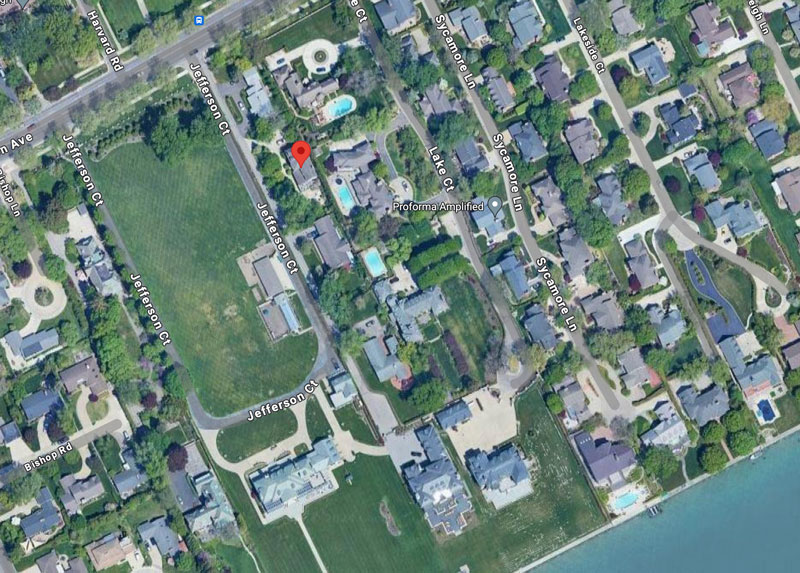
The Early Years: The House
When my family moved into the house it was quite different from today’s structure. Also, the house had been using coal for heating purposes. There was still coal in the bin when we moved in. My parents converted to oil heat within the first year.
The front entrance to the house was on the north side of the structure, facing Jefferson. Access to the front door was via a concrete stairway. The front door was approximately 6 feet above ground level. The current entrance did not exist.

Inside the current entrance, the floor level extended all the way to the wall. The lower entry and staircase were added several years later, in 1967. There was no porch, or deck, wrapped around the house, as exists today. On the south facing side of the house, or backside, there was a fairly large, unheated but fully enclosed porch with a door and stairway down to the back yard. Indoor access to the porch was through the kitchen as well as an interior rear staircase to the second floor. The yard extended for approximately 200 feet south and contained several large trees, concrete block pathways, and in ground brick/cement vegetable cellar. My father dismantled the cellar and used the bricks and concrete pathway blocks to install a patio proximate to the house. Quite a job, as I recall.
The first-floor layout consisted of four rooms, a pantry, and the kitchen. Upon entering the house from the front door, was the entrance hallway. This room was tiled and had a fireplace on the west wall. A staircase wound around the west wall to the second floor. Moving clockwise from the front door entrance, one entered the living room, which had a fireplace and archway access to the dining room, which in turn had access to both the family room, through French doors, on the west and, on the south side, through the pantry, to the kitchen. Access to the hallway from the family room completed the circle.
On the second floor, there was a bedroom, directly above the hallway [used by my mother for sewing and whatever]. Connecting to this room, through a doorway, was the master bedroom, directly above the living room. A second doorway from the master bedroom accessed a lounging room, directly above the dining room. Essentially, this three-room complex comprised the master bedroom suite that had an en suite bathroom. Across from the parental suite, was a bedroom. Continuing down the second-floor hallway, one reached a second bedroom, with adjacent bathroom, at the south end of the house. Pivoting north at that point, one accessed a stairway to the third floor, which had a larger bedroom and bathroom en suite.
My parents had many renovation projects upon moving into the house. The third floor originally had two small rooms. These were enlarged to one room by taking down a wall. These walls were plaster laid over wooden boards. No dry wall in those days. I helped but Dad did most of the work. Most of the other work involved painting, papering, and updating of plumbing, et cetera. I would not consider these efforts “major renovation.” That was to come later, however.
Next week we will continue the story, including the terrible fire that engulfed the property, the middle years, and the birth of Jefferson Court.
*Photos courtesy of the Higbie Maxon Agney archives unless stated.
** Research, information, and data sources are deemed reliable, but accuracy cannot be fully guaranteed.
Written by Jeff Farkas, edited by Katie Doelle
Copyright © 2024 Katie Doelle


